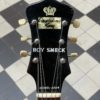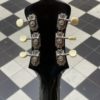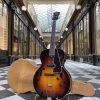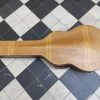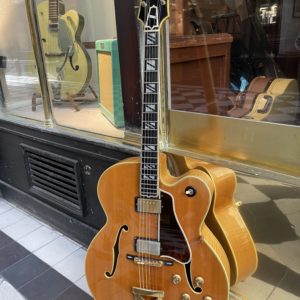1938 RECORDING KING ROY SMECK MODEL-A104
The prices indicated correspond to the price in the case of payment in-store or by bank transfer. In the case of payment by credit card via the website, a processing fee of [3.25% + €0.25]* will be applied to the total amount of the basket, including delivery costs.
Straight from the dawn of the electric era, a rare 1938 Recording King Roy Smeck Model-A104, in exceptional original condition!
To fans of pre-war electric guitars, this model will immediately suggest another, the most recognizable and iconic model produced in the period: the Gibson ES-150 – closely linked to jazzman Charlie Christian, who would be one of the first to popularize electric jazz in the context of the nascent bebop scene. And indeed, despite the absence of the Gibson brand, the model shown here was built in the same place, at the same time, according to the same specifications and probably by the same hands as those that shaped the ES-150!
To understand the advent of this instrument, we must go back to the previous decade, when Gibson was weighing its options for surviving the fierce competition from banjo makers, the quintessential instrument of the burgeoning jazz era, which was enjoying dazzling success at the time, while the old Kalamazoo company was (to its credit) obstinately building high-end F-5 mandolins, convinced of a bright future for their founding instrument. The departure in 1924 of Lewis Williams, C.V. Buttleman and Lloyd Loar, respectively the general manager, sales manager and chief acoustic engineer, marked the end of an era for Gibson, since it was these three figures who were the catalyst for the fierce determination to continue developing and building mandolins despite the obvious shifts in musical trends and tastes. Gibson then appointed a new team better able to react to the turn that the American musical landscape was taking in the person of Guy Hart and Frank Campbell, who replaced Williams and Buttleman. They began the renovation of the company, very quickly setting up the Mastertone line of banjos which not only made up for Gibson’s delay in the field but surpassed the majority of their competitors, and also extended the range of archtop guitars alongside the first flattops in 1926.
Campbell happened to be endowed with a particularly sharp commercial genius, and embarked on an approach that would ensure the sustainability of Gibson for at least two decades to come: the manufacture of instruments under other brands, intended to be distributed by various retailers – this was the golden age of mail order, and all the major brands (Sears Roebuck, Grossman, etc.) offered in their catalog a variety of musical instruments, including of course guitars. From then on, the brands made in Kalamazoo multiplied: Kel Kroydon, Kalamazoo, Cromwell and Recording King, to name just the main ones among a total of around thirty names (not necessarily produced continuously) between the end of the 1920s and the beginning of the Second World War. It should be noted that this production, ancillary to guitars bearing the Gibson logo, was a lifesaver for the manufacturer on several occasions: despite the Great Depression that hit the United States from 1929, the economic guitars produced and sold en masse like Kalamazoo guitars allowed Gibson to keep its head above water even as many other manufacturers were sinking.
This brings us to Recording King, the brand under which Gibson produced instruments for the mail order giant Montgomery Ward: the relationship between the two brands dates back to 1928, and in the second half of the 1930s the distributor’s catalog included a wide selection of mandolins, banjos, guitars and lapsteels produced directly in Kalamazoo! Another notable feature of the instruments resulting from this collaboration are the endorsements of several trending artists at the time, who attached their fame to the guitars: Carson Robison and Ray Whitley, two famous singing cowboys had their names associated with various flat top models, and Roy Smeck, a multi-instrumentalist prodigy who already has several artist models with Gibson was offered his own line made up of two Hawaiian electric models and a Spanish electric model: the Recording King Roy Smeck Model-A104, designated Model 1127 in the Montgomery Ward catalog and in Gibson’s ledgers.
This guitar is virtually identical to the ES-150 as it was produced in the late 1930s, featuring a solid spruce top with X-bracing, maple back and sides (arched on the Recording King while flat on the ES-150), a mahogany neck with a rosewood fingerboard, and the single-coil blade pickup, introduced 3 years earlier on Gibson’s first electric instruments! This is where the aesthetic differences begin: while technically identical to the pickup fitted to the ES-150, the Recording King’s pickup features an oval top plate instead of the hexagonal shape on the Gibson; the headstock also features an alternative arrowhead shape, typically found on other Kalamazoo brands as well as a few Gibson models produced just before the war (such as the final version of the EH-100); of course, the headstock veneer featuring a mother-of-pearl cartouche indicating the Recording King brand and a stenciled inscription giving Roy Smeck’s name and the model number; some differences in the hardware, such as the pickguard material, the style of the Bakelite buttons, and the tailpiece; finally, the pickup is rotated 180° from the usual positioning of an ES-150 in the neck position, so that it is placed equidistant from the fingerboard and the bridge – in this regard, it is interesting to note that most Recording King Roy Smecks we have encountered have the pickup positioned like that of the ES-150, with the pots placed on the upper part of the body on the bass side. The different configuration of the guitar presented here is due to the fact that it is one of the first models built during the production period running from 1938 to 1940, and that Gibson initially re-used a design already employed on the electric guitars they had been building under the Cromwell brand name since the previous year – it can be assumed that Recording King subsequently requested a change in the appearance of the model intended for them so that there would be no confusion between the two on the part of buyers (ironic, since again these models were all basically identical!)
The 86-year-old instrument comes to us today in absolutely stunning condition, and it is without exaggeration one of the most pristine and unadulterated pre-war instruments we have ever encountered! It remains perfectly original, with all its hardware, Sunburst varnish, electronics and pickup. We have applied ourselves to the complete optimization of its adjustment, with a planimetry of the frets, the adjustment of its nut and its bridge, and thus find an ideal playability with a low action and a correct intonation. This is the ideal instrument to discover the very special tone of the Charlie Christian pickup, while even unplugged the instrument has a great acoustic tone owing to its construction characteristics.
To complete this exceptional lot, the guitar is sold with its original Geib tweed case, also perfectly preserved after almost nine decades!

















